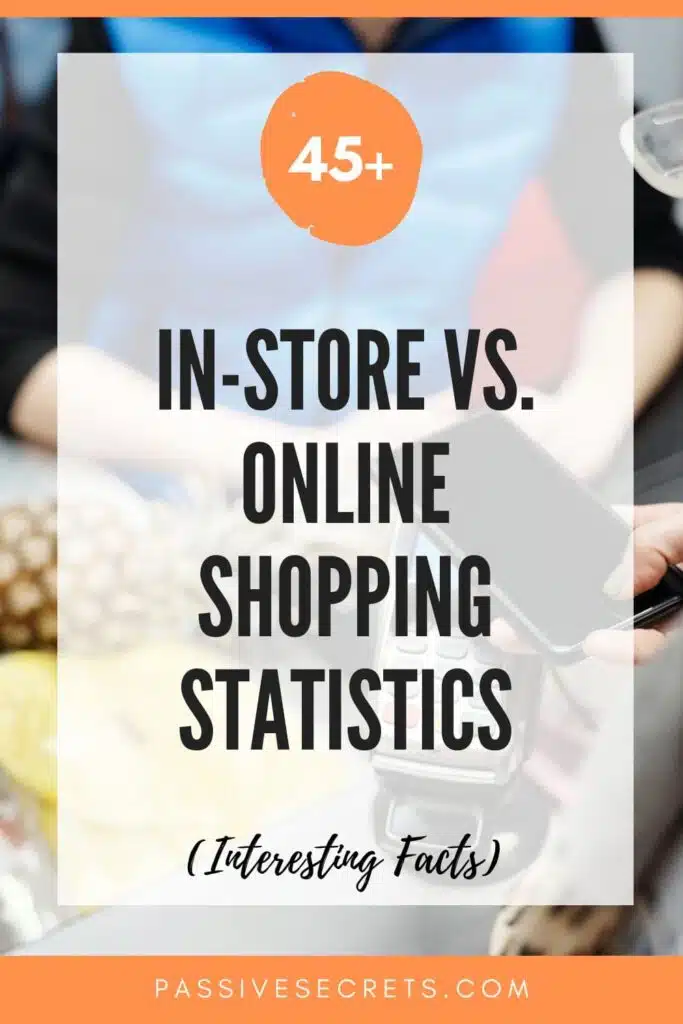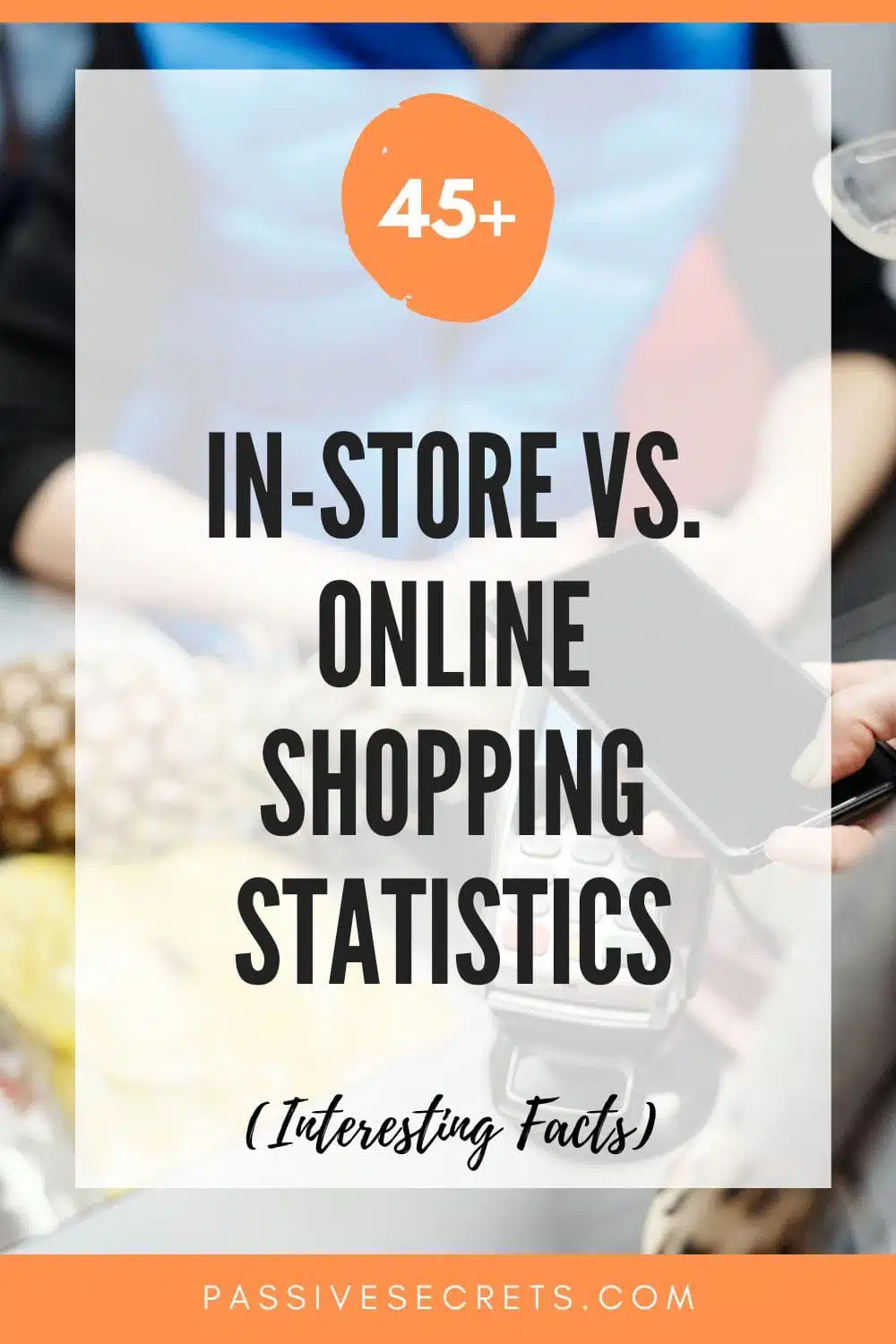
The retail industry has taken a dramatic turn in recent years as the debate between in-store and online shopping continues to evolve.
What was once a simple choice between the experience of a physical store and the convenience of e-commerce has suddenly become complex.
As consumers increasingly turn to e-commerce, retailers must adapt and rethink their strategies.
But what do the numbers say? In this article, we’ll learn the latest in-store vs. online shopping statistics and explore the trends, preferences, and behaviors that are reshaping the world of retail.
From conversion rates to customer satisfaction, we’ll examine the key metrics that matter most.
Get ready to discover the insights that will shape the future of shopping.
Key In-store Vs Online Shopping Statistics
- In 2023, US consumers collectively spent $7.071 trillion on in-store purchases and $1.257 trillion on online shopping, totaling $8.328 trillion in retail sales.
- Consumers perceive physical stores as more trustworthy than online-only brands.
- In 2023, online shopping constituted approximately 19% of global retail sales, and experts predict that e-commerce will expand to nearly 25% of total worldwide retail sales by 2027.
- Global Gen Z shoppers make impulsive online purchases primarily due to attractive sales and discounts (43%), self-indulgence and rewards (39%), the thrill of discovering new products, and the ease of online checkout (both at 37%).
- More than a third (38%) of teens aged 13-17 express no preference between online and in-store shopping.
- 39.5% of consumers are driven to shop online by the availability of coupons and discounts, while 25.7% are motivated by the opportunity to earn loyalty points.
General In-store Vs Online Shopping Statistics
1. In 2023, US consumers collectively spent $7.071 trillion on in-store purchases and $1.257 trillion on online shopping, totaling $8.328 trillion in retail sales. (source)
2. As of early 2023, around 43% of consumers in the United States preferred online shopping over in-store, marking the highest online shopping preference among countries. In contrast, more shoppers in countries like Austria, Finland, and New Zealand favored physical stores. (source)
3. In a 2022 survey of 9,989 U.S. consumers, 36% indicated “Clothing” as their preference for online versus offline purchases. (source)
4. The American Customer Satisfaction Index (ACSI) reported that customer satisfaction with e-retail in the United States scored 80 out of 100 in 2023. (source)
5. In a 2024 online survey, 45% of U.S. respondents stated that they always research on the Internet before making a major purchase, reflecting their attitudes towards online shopping. (source)
6. According to a 2024 online survey of 10,051 U.S. respondents, the most popular online purchase categories were Clothing (43%) and Shoes (33%). (source)
7. Amazon.de was Germany’s most visited online marketplace in December 2023, capturing over 53% of desktop visits, followed by eBay.de with nearly 20%. (source)
8. In the same period, Amazon.com became the top online marketplace in the U.S., accounting for 58% of desktop traffic in the marketplace category, with eBay.com at 11.86%. (source)
9. A 2022 survey found that 45% of U.S. online shoppers believed most of their returned products were resold, 36% were unsure, and 17% thought the items were discarded. (source)
10. Returns on online purchases in the U.S. totaled nearly $248 billion in 2023, reflecting a 16.4% increase from approximately $213 billion in the previous year. (source)
11. As of December 2023, Shein.com was the most visited fast-fashion e-commerce site globally, capturing over 2.6% of desktop traffic, followed by Nike at 1.93%. (source)
12. In August 2022, about 82% of consumers aged 26-35 globally had purchased fashion online in the past year, the highest among age groups. Also, 73% of consumers aged 65 and older shopped for clothes online. (source)
13. Amazon dominated the U.S. online retail market in 2023, holding a 37.6% share, followed by Walmart’s e-commerce site at 6.4% and Apple at 3.6%. (source)
14. DoorDash was the most downloaded online food delivery app in the U.S. in 2023, with over 21 million downloads, surpassing competitors like Uber Eats. (source)
15. Retail trade sales in April 2024 were up 0.2% compared to March 2024, with nonstore retailers showing a 6.8% increase from the previous year. (source)
16. Total retail trade sales from March to May 2024 increased by 2.9% year-over-year, with a slight decline of 0.2% from March to April 2024. (source)
17. Adjusted for seasonal variation, U.S. retail and food services sales in May 2024 totaled $703.1 billion, up 0.1% from the previous month and 2.3% from May 2023. (source)
18. Despite earlier challenges, store enjoyment among shoppers increased to 59% in March 2024, up from a low point in January 2023. (source)
19. Consumers perceive physical stores as more trustworthy than online-only brands. (source)
20. As of early 2024, 21% of middle-income consumers prefer buying groceries and household goods online, citing convenience and quality as factors. Also, the preference for in-store shopping reached a high in early 2024, especially among older consumers, while the preference for online shopping remained steady. (source)
21. Online shopping for beauty products is increasingly popular, particularly among men, with 28% preferring this method. (source)
22. In 2023, online shopping constituted approximately 19% of global retail sales, and experts predict that e-commerce will expand to nearly 25% of total worldwide retail sales by 2027. (source)
23. A recent study of leading e-commerce categories in the US reveals that clothing is the most favored, with 43% of consumers purchasing these items online in 2023. This is followed by shoes at 33%, food and beverages at 26%, bags and accessories at 25%, and cosmetics and body care at 23%. (source)
24. Between 2020 and 2029, the total number of online shoppers in the US is projected to grow by 60.7%, with an average annual increase of 5.4%. (source)
25. However, the growth rate of online shoppers is expected to slow down in the coming years. By 2025, it is forecasted to decrease to 5.4%, then to 4.2% in 2026 and 4.6% in 2027. The anticipated annual growth rates are 3.8% for 2028 and 2.9% for 2029. (source)
26. In 2024, the number of online shoppers in the US represents an 8.1% annual rise from 2023, reaching approximately 270.11 million. This is the fastest growth seen in at least four years. For reference, the growth rates were 6.6% in 2022 and 6% in 2023. (source)
Shopping Patterns According to Different Ages
27. A survey conducted in 2022 indicated that Gen Z showed the most inclination (44%) towards shopping with brands offering sustainable return and shipping methods, followed by Millennials (42%) and Boomers (35%). (source)
28. In the first quarter of 2023, Gen Z shoppers preferred online shopping in categories such as entertainment and fashion, while they preferred in-store shopping for groceries, pharmaceuticals, and home and garden items. (source)
29. According to global Gen Z shoppers, the main reasons for making unplanned online purchases included taking advantage of sales and deals (43%), treating or rewarding themselves (39%), and the excitement of discovering new items and the convenience of online checkout (each at 37%). (source)
30. A survey revealed that nearly 80% of Gen Z consumers worldwide valued the ease of comparing prices and saving time as the primary benefits of online shopping, along with a wider product selection, more payment options, and better product information. (source)
31. As of the first quarter of 2023, 44% of Gen Z consumers reported starting their shopping journey in online stores, 40% used search engines, and 35% visited physical stores, indicating a strong preference for digital channels. (source)
32. According to a survey, there’s a correlation between age and cross-border shopping: in 2022, 60% of Gen Z shoppers (18-24 years old) had made cross-border orders, followed by 57% of millennials, 37% of Gen X, and 20% of boomers. (source)
33. In the first quarter of 2023, France and Poland had the highest percentage of Gen Z consumers (82%) buying pre-owned items online, while Norway (83%) and Spain (79%) led in selling second-hand items. (source)
34. Younger consumers, particularly Gen Z and millennials show a higher tendency than older generations to wait for discounts before making online purchases. In 2022, 66% of Gen Z and 67% of millennials were willing to wait for lower prices, compared to 44% of Gen X consumers. (source)
35. Gen Z distrusts e-commerce-only brands but still engages in shopping behaviors. (source)
36. A survey of U.S. teenagers found that 56% favored Amazon as their top online shopping website, with Shein following at approximately 7%. (source)
37. Gen Z adults are big shoppers. They make more discretionary purchases than most and are especially likely to make five or more purchases per category per month. (source)
38. More than a third (38%) of teens aged 13-17 express no preference between online and in-store shopping. (source)
Reasons for Online Shopping
39. The primary reason people shop online is convenience, with 33% of US consumers citing it as their motivation. Fast shipping options (31%) and free or low-cost shipping (28%) follow closely behind. (source)
40. A recent survey indicates no simple answer to how frequently people shop online. About 21% of US consumers shop online once a month or less, 12% shop weekly, and approximately 45% make multiple online purchases each week. (source)
41. Online shopping is a daily activity for many, with 21% of consumers buying items online at least once daily. Of these, 10% shop once daily, while 11% make several daily purchases, meaning roughly one in five consumers shop online daily. (source)
42. Feedback from other internet users is also a significant factor in online shopping decisions. About 32.6% of consumers are influenced by customer reviews, and 22.4% are motivated by social media likes and comments. (source)
43. Statistics reveal that 39.5% of consumers are driven to shop online by the availability of coupons and discounts, while 25.7% are motivated by the opportunity to earn loyalty points. (source)
44. Among the top reasons for online shopping, next-day delivery is significant, with 31.8% of online shoppers considering it a motivating factor. Additionally, 30.4% of consumers value the easy checkout process as a primary reason for shopping online. (source)
45. The option to pay upon delivery influences consumers’ willingness to shop online. Nearly 18.2% of consumers list cash on delivery as a top reason for online shopping. Alongside enjoying free delivery, online shoppers appreciate being able to pay only when they receive their items. Additionally, the ease of returning purchases motivates 31.4% of online buyers. (source)
46. The number of digital shoppers is predicted to rise in the upcoming years: 284.65 million in 2025, 296.59 million in 2026, and 310.23 million in 2027, surpassing 300 million for the first time. By 2029, the number is expected to reach 331.46 million. (source)
Conclusion
The in-store vs. online shopping discussion is far from over, and it’s clear that both channels offer unique advantages that cater to different consumer needs and preferences.
Moving forward, the retailers who succeed will be those who can seamlessly integrate their physical and digital experiences.
Whether you’re a seasoned shopper or a retail professional, the evolution of shopping patterns is a fascinating topic worth following closely.
As consumer behavior shifts, the only constant is change—and the businesses that can easily adapt will thrive.
Frequently Asked Questions
Are people more likely to buy in-store or online?
Online shopping is generally more convenient. It allows customers to browse various products, compare prices, and receive instant gratification from their purchases.
What percentage of the UK is online shopping vs in-store?
71% of shoppers spend more in-store than online.
What is the difference between eCommerce and in-store?
Retail involves selling products through physical stores like shopping malls, department stores, etc. At the same time, e-commerce pertains to online selling, where products are stored in a warehouse and displayed as pictures on a website.
Is it better to shop in-store or online?
Both shopping methods have advantages, offering buyers various choices based on their needs and preferences.

Other Similar Statistics Report You Should Know:
- B2B Sales Statistics: Latest Insights and Trends
- 50+ Essential Traditional Marketing Statistics & Trends
- 60+ QR Code Statistics, Usage, Forecasts & Trends
- 90+ Useful Marketing Jobs Statistics & Facts (Latest Report)
- Sales Enablement Statistics: The Data You Need to Drive Sales Growth
- Social Media Addiction Statistics
- Latest In-Game Advertising Statistics
- From Passion to Profit: 120+ Creator Economy Statistics
- 80+ Big Marketing Software Statistics
- 45 Interesting Healthcare Marketing Statistics & Trends
- Print Marketing Statistics: Ad Spending, Market Size, & More
- Key Short-Form Video Statistics and Trends You Should Know
- 49 Interesting Emotional Marketing Statistics
- 90 Amazing Millionaire Statistics
- 70+ Top Law Firm Marketing Statistics & NEW Trends
- Millennials on Social Media Statistics
- 23 Most Interesting First Impression Statistics To Know
- 60+ Interesting Storytelling Statistics, Facts & Huge Trends
- Amazon Book Sales Statistics: Intriguing Numbers and Facts
- 61+ Useful Podcast Advertising Statistics And Trends
- 50+ Useful Call Center Statistics And Trends
- 50 Crucial Amazon Advertising Statistics & Trends
- 65+ Must-Know Pay-Per-Click Statistics
- 40+ Interesting Omnichannel Marketing Statistics & Trends
- Multi-Level And Network Marketing Statistics, Facts & Trends
- Virtual Event Statistics & Benchmarks For Marketers & Organizers
- 55 Interesting Direct Mail Marketing Statistics and Trends
- B2B Lead Generation Statistics, Facts, Trends, Benchmarks, & Market Size
- 52 Valuable Trade Show Statistics and Trends
- 100+ Top Digital Marketing Vs. Traditional Marketing Stats
- 110+ Important Social Media Advertising Statistics & Trends
- 50 Interesting Organic Vs. Paid Search Statistics To Know
- 41+ MOST Important Copywriting Statistics To Know
- 80+ Useful Sales Funnel Statistics & Conversion Rates
- 40+ Latest Multi-Channel Marketing Statistics & Huge Trends

